Mitral Valve: Difference between revisions
No edit summary |
>Cvdw No edit summary |
||
| (8 intermediate revisions by 3 users not shown) | |||
| Line 1: | Line 1: | ||
==Anatomy== | ==Anatomy== | ||
The mitral valve consists of two valve leaflets , the anterior | The mitral valve consists of two valve leaflets, the anterior leaflet (AMVL) and the posterior leaflet (PMVL), which together have a surface of 4 - 6 cm<sup>2</sup>. Via chordae tendineae, small tendons which ensure that the leaflets do not prolapse, the valve leaflets are attached to two major papillary muscles (anterolateral en posteromedial) in the left ventricle. | ||
{| class="wikitable" cellpadding="0" cellspacing="0" border="0" | {| class="wikitable" cellpadding="0" cellspacing="0" border="0" | ||
|- | |- | ||
|bgcolor="#FFFFFF" align="center"|[[Image:Mvalv. | |bgcolor="#FFFFFF" align="center"|[[Image:Mvalv.svg|400px]] | ||
|- | |- | ||
!Top view of the normal heart showing the coronary arteries and four valves including the mitral valve<cite>1</cite> | !Top view of the normal heart showing the coronary arteries and four valves including the mitral valve with its anterior (A) and posterior (P) leaflets<cite>1</cite> | ||
|} | |} | ||
The mitral valve is bringing many scan faces in pictures: | The mitral valve is bringing many scan faces in pictures: PLAX, PSAXmv, AP4Ch, AP5Ch, AP2Ch, AP3Ch and subcostal4Ch. Mitral valvular insufficiency should be considered in all views. When significant abnormalities of the mitral valve are suspected, TEE (particularly 3D TEE) can assist in assessing the severity. | ||
{| class="wikitable" cellpadding="0" cellspacing="0" border="0" | {| class="wikitable" cellpadding="0" cellspacing="0" border="0" | ||
| Line 15: | Line 15: | ||
|Video | |Video | ||
|- | |- | ||
!3D (TEE) view of MV with a chorda rupture | |||
|} | |} | ||
| Line 35: | Line 35: | ||
|} | |} | ||
==The scallops of the mitral valve== | ==The scallops of the mitral valve== | ||
The two leaflets are divided into a total of six scallops: A1, A2, A3 (anterior) | The two leaflets are divided into a total of six scallops: A1, A2, A3 (anterior) and P1, P2, P3 (posterior). | ||
{| class="wikitable" cellpadding="0" cellspacing="0" border="0" | {| class="wikitable" cellpadding="0" cellspacing="0" border="0" | ||
|- | |- | ||
|bgcolor="#FFFFFF" align="center"|[[Image: | |bgcolor="#FFFFFF" align="center"|[[Image:MV_AP2CH.svg|235px]] | ||
|bgcolor="#FFFFFF" align="center"|[[Image: | |bgcolor="#FFFFFF" align="center"|[[Image:MV_PLAX.svg|235px]] | ||
|bgcolor="#FFFFFF" align="center"|[[Image: | |bgcolor="#FFFFFF" align="center"|[[Image:MV_PSAX.svg|235px]] | ||
|- | |- | ||
!MV AP2CH | !MV AP2CH | ||
| Line 48: | Line 49: | ||
!MV Surgical view | !MV Surgical view | ||
|- | |- | ||
|bgcolor="#FFFFFF" align="center"|[[Image: | |bgcolor="#FFFFFF" align="center"|[[Image:MV_AP4CH.svg|235px]] | ||
|bgcolor="#FFFFFF" align="center"|[[Image: | |bgcolor="#FFFFFF" align="center"|[[Image:MV_surgical_view.svg|235px]] | ||
|bgcolor="#FFFFFF" align="center"|[[Image:MVtee. | |bgcolor="#FFFFFF" align="center"|[[Image:MVtee.svg|235px]] | ||
|- | |- | ||
!MV AP4CH | !MV AP4CH | ||
| Line 60: | Line 61: | ||
==Stenosis== | ==Stenosis== | ||
{| class="wikitable" cellpadding="0" cellspacing="0" border="0" | {| class="wikitable" cellpadding="0" cellspacing="0" border="0" width="400px" | ||
|- | |- | ||
!colspan="2"|Causes of mitral valve stenosis | !colspan="2"|Causes of mitral valve stenosis | ||
|- | |- | ||
!Acquired | |||
| | | | ||
*Degeneracy | *Degeneracy | ||
*Rheumatic fever | *Rheumatic fever | ||
|- | |- | ||
!Space occupying lesion | |||
| | | | ||
*Myxoma | *Myxoma | ||
|- | |- | ||
!Congenital | |||
| | | | ||
*Parachute valve | *Parachute valve | ||
| Line 79: | Line 80: | ||
|} | |} | ||
Effects of mitral stenosis : Chest pain , | ===Effects of mitral valve stenosis:=== | ||
Chest pain, of breath when lying flat, with exertion and attacks during the night or morning (cardiac asthma), possibly coughing up blood; any complaints from right valve failure, such as ankle edema. Palpitations by atrial fibrillation, which can cause embolism, such as a stroke. | |||
===Treatment=== | |||
The valve can be opened by balloon angioplasty or surgically treated by valve replacement. | |||
Click for mitral stenosis quantification . | Click [[Mitral Stenosis|'''here''']] for mitral stenosis quantification. | ||
==Insufficiency== | ==Insufficiency== | ||
{| class="wikitable" cellpadding="0" cellspacing="0" border="0" width="400px" | |||
|- | |||
!colspan="2"|Causes of mitral valvular insufficiency | |||
|- | |||
Left | !Annular dilatation | ||
| | |||
*Atrial fibrillation | |||
Acquired valve defect | *Left ventricular dilatation | ||
*Left atrial dilatation | |||
|- | |||
!Degenerative disease | |||
Flail | | | ||
*Malcoaptation at mitral valve stenosis | |||
|- | |||
!Acquired valve defect | |||
Arrhythmias ( LBBB - > diastolic MI ) | | | ||
SAM in HCM | *Billowing | ||
Mitral | *Prolapse | ||
*Floppy valve | |||
*Flail | |||
*Chordal rupture | |||
*Papillary muscle rupture | |||
|- | |||
!Secondary | |||
| | |||
*Arrhythmias (LBBB-->diastolic MI) | |||
*SAM in HCM | |||
|} | |||
Mitral valve insufficiency (MI) may result in left-sided congestive heart failure. An MI results in back flow of blood from the left ventricle into the left atrium. This may eventually result in pulmonary hypertension and pulmonary edema. Pulmonary edema is manifested by shortness of breath, initially with exertion, but later at rest, orthopnea and nocturnal dyspnea attacks. On physical examination, pulmonary edema can be detected by fine crackles, particularly in the dorsobasale lung fields. Increasing left atrial pressure and dimension may cause atrial fibrillation. | |||
Click for quantification mitral valvular insufficiency . | Click [[Mitral Insufficiency|'''here''']] for quantification mitral valvular insufficiency . | ||
==References== | ==References== | ||
<biblio> | <biblio> | ||
#1 [http://www.geisinger.kramesonline.com/3,S,89116 How the heart works] from Geisinger’s Health Library. | #1 [http://www.geisinger.kramesonline.com/3,S,89116 How the heart works] from Geisinger’s Health Library. | ||
#2 [http://www.escardio.org/education/live-events/courses/education-resource/Documents/021-1715-Geleijnse-Wbz-Tue-S05.pdf Mechanisms of Mitral regugitation | #2 [http://www.escardio.org/education/live-events/courses/education-resource/Documents/021-1715-Geleijnse-Wbz-Tue-S05.pdf Mechanisms of Mitral regugitation - ML Geleijnse.] | ||
</biblio> | </biblio> | ||
Latest revision as of 17:36, 26 February 2015
Anatomy
The mitral valve consists of two valve leaflets, the anterior leaflet (AMVL) and the posterior leaflet (PMVL), which together have a surface of 4 - 6 cm2. Via chordae tendineae, small tendons which ensure that the leaflets do not prolapse, the valve leaflets are attached to two major papillary muscles (anterolateral en posteromedial) in the left ventricle.

|
| Top view of the normal heart showing the coronary arteries and four valves including the mitral valve with its anterior (A) and posterior (P) leaflets[1] |
|---|
The mitral valve is bringing many scan faces in pictures: PLAX, PSAXmv, AP4Ch, AP5Ch, AP2Ch, AP3Ch and subcostal4Ch. Mitral valvular insufficiency should be considered in all views. When significant abnormalities of the mitral valve are suspected, TEE (particularly 3D TEE) can assist in assessing the severity.
| Video |
| 3D (TEE) view of MV with a chorda rupture |
|---|
| Examples of Mitral variants (AP4Ch) | |
|---|---|
| Video | Video |
| Normal | Degenerative |
| Video | Video |
| Prolapse | Rheumatic |
The scallops of the mitral valve
The two leaflets are divided into a total of six scallops: A1, A2, A3 (anterior) and P1, P2, P3 (posterior).
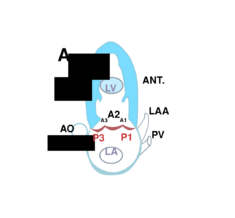
|
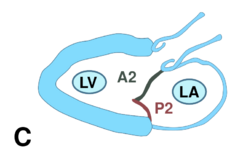
|
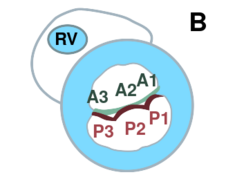
|
| MV AP2CH | MV PSAX | MV Surgical view |
|---|---|---|
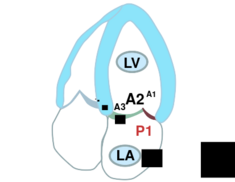
|
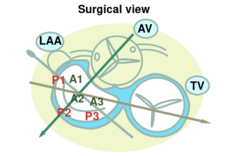
|
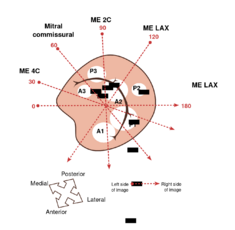
|
| MV AP4CH | MV PLAX | MV TEE views (Fig. click for animation) |
| Source image: Mechanisms of Mitral regugitation - role of 3D ultrasound illustrated by case studies - ML Geleijnse.[2] | ||
Stenosis
| Causes of mitral valve stenosis | |
|---|---|
| Acquired |
|
| Space occupying lesion |
|
| Congenital |
|
Effects of mitral valve stenosis:
Chest pain, of breath when lying flat, with exertion and attacks during the night or morning (cardiac asthma), possibly coughing up blood; any complaints from right valve failure, such as ankle edema. Palpitations by atrial fibrillation, which can cause embolism, such as a stroke.
Treatment
The valve can be opened by balloon angioplasty or surgically treated by valve replacement.
Click here for mitral stenosis quantification.
Insufficiency
| Causes of mitral valvular insufficiency | |
|---|---|
| Annular dilatation |
|
| Degenerative disease |
|
| Acquired valve defect |
|
| Secondary |
|
Mitral valve insufficiency (MI) may result in left-sided congestive heart failure. An MI results in back flow of blood from the left ventricle into the left atrium. This may eventually result in pulmonary hypertension and pulmonary edema. Pulmonary edema is manifested by shortness of breath, initially with exertion, but later at rest, orthopnea and nocturnal dyspnea attacks. On physical examination, pulmonary edema can be detected by fine crackles, particularly in the dorsobasale lung fields. Increasing left atrial pressure and dimension may cause atrial fibrillation.
Click here for quantification mitral valvular insufficiency .
References
-
How the heart works from Geisinger’s Health Library.